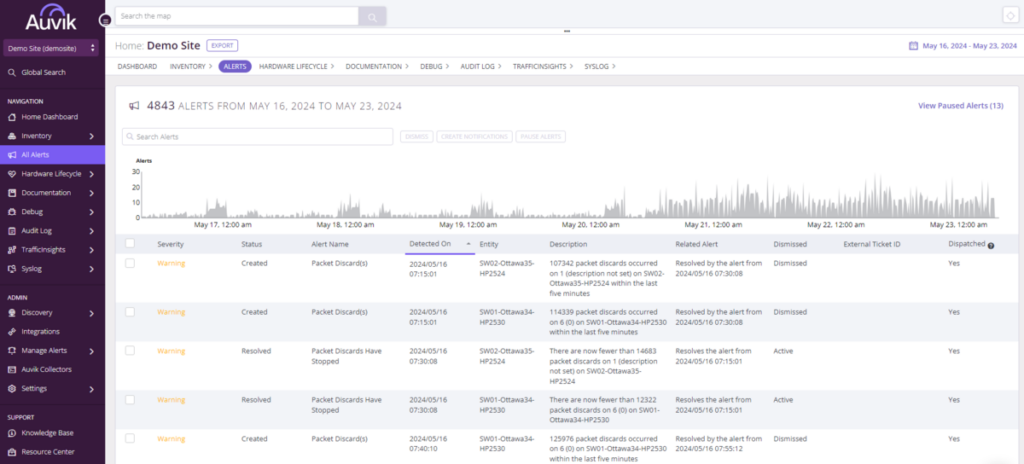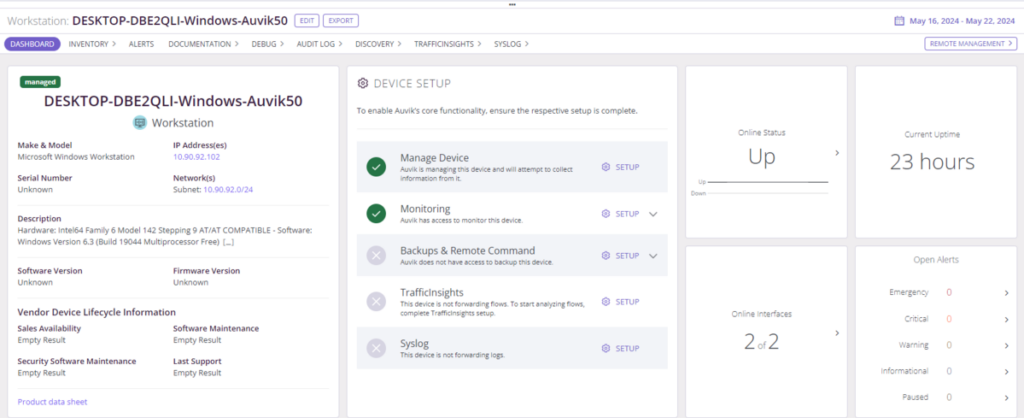When shopping around for a new network monitoring and management tool, conducting a trial is one of the best ways to find the right solution. While reviews, feature lists, and comparison charts are helpful, nothing compares to testing a system within your own network. With an Auvik free trial, you can see the results firsthand.
However, if you’re comparing multiple new tools, it can get challenging. You have to quickly get comfortable on a new platform, decide which features to focus on, figure out what’s different from the paid version, and so on. Becoming an expert on each one is neither practical nor a good use of your time.
So, how do you dive deep enough to make the trial meaningful?
Get a cheat sheet, of course!
In this cheat sheet, we’ll explain what you can expect from an Auvik free trial and how to maximize its value during your trial period.

Try Auvik Network Management
Free to try! Setup takes less than 15 minutes and you will see results in an hour.
What is an Auvik trial?
An Auvik trial is a free 14-day test run of the Auvik Network Management (ANM) platform, a cloud-based network monitoring and management application. You can sign up for an Auvik free trial here, no credit card required.
The free trial provides you with all the features of the ANM platform except data export. That means you can do everything from remote network management of networks you know well to running a network assessment on a network you’re unfamiliar with.
Auvik free trials let IT pros and MSPs try out the platform in real-world scenarios to see if it meets their needs. You can explore it on your own or get help from the ANM sales team for setup and specific use cases.
What do you need for an Auvik trial?
To get started with an Auvik trial we recommend you have:
At least one network to test
A network with multiple network devices will allow you to use different features and capabilities of the ANM platform, including network infrastructure mapping. Ideally, we recommend testing two networks: one you know well and one you don’t. The platform’s network discovery features can help you learn about the latter.
SNMP devices and credentials
To properly monitor your network, Auvik requires SNMP credentials to be provided at the beginning of trial setup. Ensure you know your SNMP credentials and have configured them on your devices. Additionally, take a look at Device community string and password best practices for tips on SNMP credentials.
SSH credentials for network devices
By adding SSH credentials with appropriate privileges, you can use ANM to back up and compare network device configurations. For the basics on SSH credentials and Auvik, check out these best practices for providing Auvik SSH access to network devices.
Enough time to get your hands dirty
Typically, you can get Auvik up and monitoring your network in well under an hour. However, we recommend taking advantage of the full 14 days to start pulling out insights that can help you improve the network.
Getting started with your Auvik trial
The ANM quick start and deployment guides are great resources to bookmark and review to help you make your Auvik trial a success.
In this section, I’ll walk through the basics to show you how easy it is to run an Auvik trial using my test network.
💡Pro-tip: Use the setup wizard for your first deployment. Using the Auvik setup wizard is NOT required, but it helps streamline the process for first-time users. The steps below walk through how to use the deployment wizard.
1. Fill out the trial signup form
Navigate to the Auvik trial signup form and fill out the information required.
Note that you can select where you want your environment deployed, which can help address data residency concerns. The form also asks for your phone number so that we can jump in and help with your trial onboarding if needed.
2. Configure your site
Once you hit let’s go, Auvik’s onboarding wizard takes you through five easy steps.

An Auvik site is a logical network location with a unique URL. Once your environment is provisioned (it takes about 30 seconds), pick a name for your site, then click Continue.

3. Set up your collector
Auvik collectors are agents that collect data from your networks. You can choose from 4 different deployment options: Docker, Windows (installer or command line), VMware virtual appliance, or a new physical or virtual machine.
Note that it is important to install the collector on a device that is always online so your network monitoring capabilities are not interrupted. The Windows installer is used below.
4. Confirm or add networks
The collector will automatically detect a network to discover. You can proceed with this network or add additional networks for the collector to discover.

5. Add your SNMP credentials
SNMP is at the heart of network monitoring. Add your SNMP v1/v2c community strings and SNMP v3 credentials here.

6. Wait a few minutes for the discovery to complete
The collector will scan your network and report back to the ANM SaaS platform. Once the process is complete, you can begin exploring the Auvik platform.

Notice there’s now a network map created and can start digging into all the cool features in an Auvik free trial. (Editor’s note: I already left a note for any future technicians with the single most important network troubleshooting tip I know 😉.)

7 must-try features for your Auvik free trial
No two networks are the same, so feel free to explore the platform and uncover what it can tell you about your network.
That said, we recommend reviewing these seven features to get a feel for the different network documentation, monitoring, management, and troubleshooting features in the ANM platform.
1. Live topology map

Auvik’s dynamic topology map provides a detailed, up-to-date view of your network architecture. You can drill down and investigate specific nodes for connectivity issues, examine specific network interfaces, or zoom out to understand your overall network architecture.
2. Automated documentation

Network maps are just one part of network documentation. You can use your free trial to view multiple preconfigured reports, integrate with PowerBI dashboards, and maintain device configurations. One of our favorite ANM features is the “compare configuration” function that provides you with a “diff” between two device configs, like this example from a Cisco ASR:

3. Historical information
Logs and historical telemetry data are often critical information for network troubleshooting or even compliance. Take some time in your Auvik trial to explore the different logs and dashboards the system generates. You can also configure syslog records to be sent from your Cisco devices to the ANM platform.

4. Pre-configured alerts

Network engineers need to know when something is wrong and have the information required to take action. ANM has a library of out-of-the-box, preconfigured alerts that make this process easy. Alerts are categorized by severity and you can track key information such as the entity that triggered the alert, related alerts, comments, and if someone was dispatched to deal with it.
5. Remote management

Think of ANM as “the RMM for your network.” That’s because it goes beyond simple monitoring and provides RMM-like functionality for your network devices. For example, you can access a network device’s terminal directly from ANM.
6. Performance monitoring

“The network is slow” is one of the toughest complaints to deal with, and maintaining quality network performance is an essential part of the job for IT and MSPs. With ANM, you have the tools to debug and resolve a wide range of network performance problems.
If you really want to dig into the details, try using flow protocols and Traffic Insights.
7. WMI and VMware monitoring

If you’re also responsible for managing Windows and VMware servers, Auvik can help there too!
Use your free trial to add Windows WMI or VMware credentials and unlock visibility to these devices. Remember to use read-only privileges on the accounts unless you have a specific reason for configuring higher-level privileges.
Auvik trial FAQs and troubleshooting
Below are some common questions and troubleshooting tips that may help you during your Auvik trial.
Where to install the Auvik collector?
Install the collector on a virtual or physical device with network connectivity to the network(s) you want to monitor. Ensure the device is consistently online so your network connectivity isn’t interrupted.
How does the Auvik collector collect data?
The Auvik collector collects data using multiple network protocols, including SNMP, SSH, ping (ICMP), and WMI. For more information, see this help article on what protocols and ports the Auvik collector uses.
What if my 2 weeks are up, but I need more time?
Contact Auvik Sales to request an extension.
Can I add someone else to my trial account?
Yes!
You can invite other users from the user interface at ADMIN → Manage Users → Users → INVITE USERS.

Do I have to use the onboarding wizard?
No.
But…
We recommend using the onboarding wizard for the first site you set up. However, it’s not mandatory, and you can configure ANM without using the onboarding wizard.
How can I troubleshoot issues with my device credentials?
To troubleshoot issues with credentials, check out the support articles below:
- Troubleshooting SNMP credentials
- Troubleshooting SSH or telnet login credentials
- Troubleshooting WMI credentials
- Troubleshooting VMware credentials
What features are not included in the Auvik trial version?
Data export is not included in the Auvik free trial version.

Still have questions about Auvik trials?
An Auvik trial is a great way to get hands-on with network management without a financial commitment. Using the steps we covered in this article, you can use the ANM platform in a real-world environment and see how Auvik can help you address network management challenges.
If you’re not quite ready to try Auvik for yourself but would like an expert to walk you through the details, sign up for an expert-led Auvik Network Management demo.
Or, if you’re interested in trying ANM, but don’t have a viable test network, request free access to our preconfigured sandbox environment. In the sandbox environment, you can view a variety of ANM features in our test network so you can get hands-on with portions of the platform that are interesting to you.


